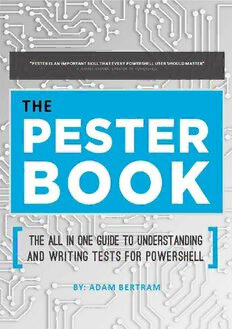
The Pester Book: The All-in-One Guide to Understanding and Writing Tests for PowerShell PDF
Preview The Pester Book: The All-in-One Guide to Understanding and Writing Tests for PowerShell
The Pester Book (Kindle Version) Adam Bertram 2 The Pester Book (Kindle Version) Adam Bertram This book is for sale at http://leanpub.com/pesterbookkindle This version was published on 2020-03-17 * * * * * This is a Leanpub book. Leanpub empowers authors and publishers with the Lean Publishing process. Lean Publishing is the act of publishing an in- progress ebook using lightweight tools and many iterations to get reader feedback, pivot until you have the right book and build traction once you do. * * * * * © 2020 Adam Bertram 3 Table of Contents About the Author Foreword Feedback Code Samples Introduction Testing as Institutional Memory Testing Drives Better Modularization Tests as Functional Specifications Tests in Automated Build Pipelines Where We’re Not Going Resources Part I - Pester Concepts Block Introduction Describe Blocks Context Blocks It Blocks Before and After Blocks Summary TestDrive and TestRegistry Using TestDrive Using TestRegistry Summary Assertions Using the Should Assertion Understanding Should Operators Testing Collections Other Tests Testing Errors 4 Adding Custom Assertion Operators Because Summary Test Cases Creating Tests for Different Parameters Using the TestCases Parameter Using the Test Name Token Summary Mocking Introduction Mock Walkthrough Mock Assertions Summary Code Coverage Why Code Coverage? Using Pester to Measure Code Coverage Getting Granular with Code Coverage Summary Gherkin Files Features Scenarios Steps Step Definitions Running Gherkin Tests Summary Part 2: Using Pester Controlling Test Results Pending and Skipped States Forcing Pass/Fail States Summary Working with Pester Output nUnit XML Returning Failed Tests as Exit Codes 5 Summary Tagging Introduction to Tagging Tagging Strategies Summary Modules and Dot-Sourced Script Gotchas Scripts with Functions Modules Summary Advanced Mocking Mocking Specific Object Types Mock Scope Module-Level Mocks Parameter Filters Summary Mocking the Unmockable .NET Methods Creating Wrapper Functions “Overwriting” .NET Methods with a ScriptMethod Using “Stubbed” Commands Asserting Mocks “Transitively” Summary Improving Code Coverage Step #1: Getting a Baseline Step #2: Build the Test Framework Step #3: Create the Mocks Step #4: Know the “Before” Code Coverage Step #5: Build all Tests Step #6: Re-check Code Coverage Summary Infrastructure Testing Analyzing the Code Getting Testing Dependencies in Place Prototyping the Infrastructure Tests 6 Assessing the Current Environment Writing the Infrastructure Tests Dependencies Operational Validation Framework (OVF) Summary Troubleshooting and Debugging Sending Variables to the Console with Write-Host Using Debugger Breakpoints During Tests Summary Test Walkthrough #1 Analyzing the Code Refactoring Deciding What to Test Find the Shortest Code Path Creating Test(s) for the Shortest Code Path Building Tests for Other Code Paths Summary Test Walkthrough #2 Understand the Subject Designing Tests Writing the Tests ImportVariables Parameter ImportModules Parameter RunspaceTimeout Parameter Parameter parameter Summary Part 3: Hands-On Design and Testing Buildling Testable Code Modularization Limit Function Input Input Via Parameters Managing Output Properly Summary Test Design Practices 7 Ensuring Code “State” Doesn’t Change The Input/Execution/Output Pattern Choosing When to Create Describe Blocks Naming Conventions Summary Part 4: Pester Cookbook Recipe: Testing for Live Conditions Recipe: Testing for Installed Software Recipe: Ensuring all Functions in a Module Have Tests Recipe: Testing External Applications The Background Testing Exit Codes from Standalone EXE files Recipe: Testing Syntax Recipe: Testing Remote Script Blocks Resources Video Courses Articles 8 About the Author Adam Bertram is a 20-year veteran of IT and experienced online business professional. He’s an entrepreneur, IT influencer, Microsoft MVP, blogger at adamtheautomator.com, trainer and content marketing writer for multiple technology companies. Adam is also the founder of the popular IT career development platform TechSnips. Catch up on Adam’s articles at adamtheautomator.com, connect on LinkedIn or follow him on Twitter. 9 Foreword Years ago, when I started writing PowerShell, I felt a spark. It was one of those sparks that get you excited to go to work. It was a spark that activated my inner geek and gave me an excellent sense of accomplishment after I had automated something. That spark has since turned into a fire which has energized practically my entire career. PowerShell is now a big part of my work life. This is what Pester feels like. That’s big! Pester is a product that’s gotten me probably too excited sometimes and made my eyes light up with satisfaction when I see all of that lovely green output scrolling down the screen to confirm the success of my code. As I’ve worked with Pester over the years, I always performed a TDD-hybrid approach with it. TDD is writing failing tests first and then only writing the code that makes the tests pass. In a previous life, I was a Senior Automation Engineer using PowerShell, which, in a roundabout way, is the same thing as a PowerShell developer. I worked on code that provisioned test environments for my developers as well as code for projects for clients. Before Pester, I would write thousands of lines of code, run it, fix it, run it, fix it, run it ad infinitum. It “worked” for the most part until some unknown bug crept in or someone else on my team made a change I wasn’t expecting, and it would break. I’d then have to dive in and spend time researching, fixing, and sometimes breaking other things in the process. At the time, I thought it was just how you wrote PowerShell code. I was wrong. I thought that testing—and thus Pester—was a waste of time. Why would I want to essentially to write the same code again to confirm I wrote the code in the first place? To me, it was a huge time drain for little value. That is until I decided to buckle down and force myself not to write a single line of code that wasn’t covered by a unit test. This is my story. 10
